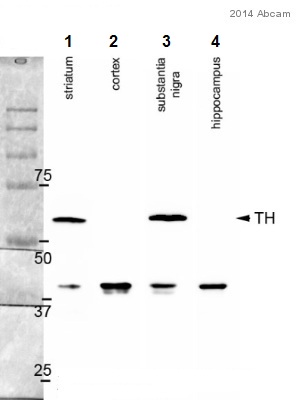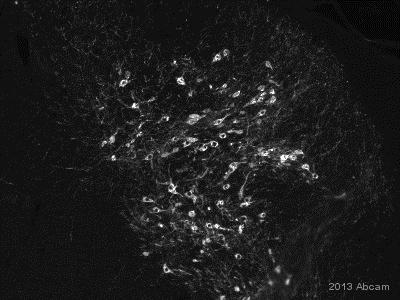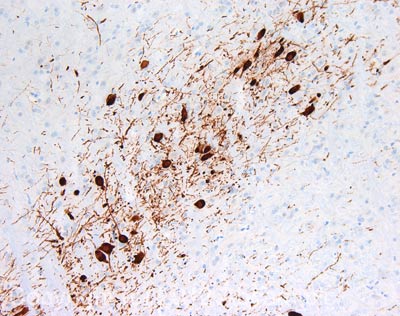
All lanes : Anti-Tyrosine Hydroxylase antibody (ab117112) at 1/10000 dilutionLane 1 : Mouse Brain Tissue lysate(striatum)Lane 2 : Mouse Brain Tissue lysate(cortex)Lane 3 : Mouse Brain Tissue lysate(substantia nigra)Lane 4 : Mouse Brain Tissue lysate(hippocampus)Lysates/proteins at 30 µg per lane.SecondaryDonkey anti-rabbit HRP cojugated polyclonal at 1/10000 dilutiondeveloped using the ECL techniquePerformed under reducing conditions.

IHC-FoFr image of Tyrosine 3-monooxygenase staining in ventral tegmental area of the mouse cortex. Tissue was fixed (animals perfused fixed) with 4% PFA and later postfixed overnight in the same fixative. They were cryoprotected in 30% sucrose and cut using cryostat. Samples were incubated with ab117112 (1/3000) for 18 hours at 25°C and were secondary stained with AlexaFluor® 488 conjugated donkey anti-rabbit antibody (1/1000).See Abreview

IHC image of Tyrosine 3-monooxygenase staining in sagittal 6 week rat brain formalin fixed paraffin embedded tissue section, performed on a Leica BondTM system using the standard protocol F. The section was pre-treated using heat mediated antigen retrieval with sodium citrate buffer (pH6, epitope retrieval solution 1) for 20 mins. The section was then incubated with ab117112, 0.1µg/ml, for 15 mins at room temperature and detected using an HRP conjugated compact polymer system. DAB was used as the chromogen. The section was then counterstained with haematoxylin and mounted with DPX. For other IHC staining systems (automated and non-automated) customers should optimize variable parameters such as antigen retrieval conditions, primary antibody concentration and antibody incubation times.


